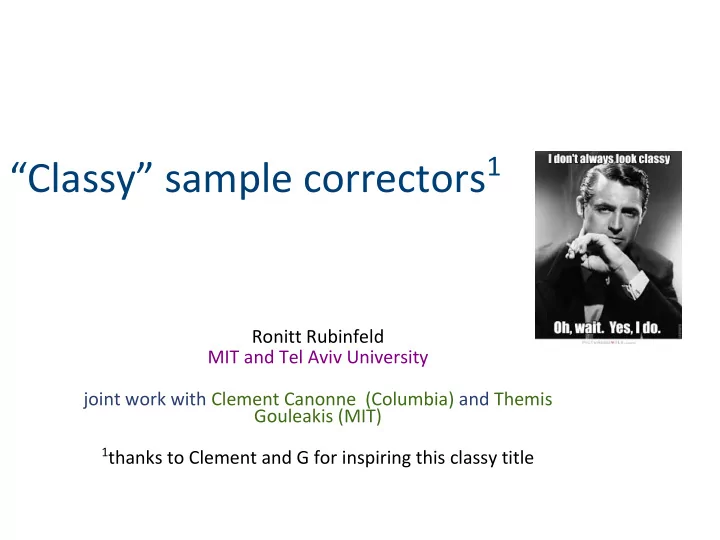

“Classy” sample correctors 1 Ronitt Rubinfeld MIT and Tel Aviv University joint work with Clement Canonne (Columbia) and Themis Gouleakis (MIT) 1 thanks to Clement and G for inspiring this classy title
Our usual model: p samples Test/Learn
What if your samples aren’t quite right?
What are the traffic patterns? Some sensors lost power, others went crazy!
Astronomical data A meteor shower confused some of the measurements
Teen drug addiction recovery rates Never received data from three of the community centers!
Whooping cranes Correction of location errors for presence-only species distribution models [Hefley, Baasch, Tyre, Blankenship 2013]
What is correct?
What is correct?
What to do? • Outlier detection/removal • Imputation • Missingness • Robust statistics • … What if don’t know that the distribution (and even noise) is normal, Gaussian, …? Weaker assumption?
A suggestion for a methodology
What is correct? Sample corrector assumes that original distribution in class P (e.g., P is class of Lipshitz, monotone, k- modal, or k -histogram distributions)
Classy Sample Correctors • q P q’
Classy Sample Correctors • 1. Sample complexity per output 2. Randomness complexity per sample of q’ ? output sample of q’ ?
Classy “non-Proper” Sample Correctors • q P P’ q’
A very simple (nonproper) example •
k -histogram distribution 1 n
Close to k -histogram distribution 1 n
A generic way to get a sample corrector:
An observation Agnostic learner Sample corrector What is an agnostic learner? Or even a learner?
What is a ``classy’’ learner? •
What is a ``classy’’ agnostic learner? •
An observation Agnostic learner Sample corrector Corollaries: Sample correctors for - monotone distributions - histogram distributions - histogram distributions under promises (e.g., distribution is MHR or monotone)
Learning monotone distributions •
Birge Buckets • You know the boundaries! Enough to learn the marginals of each bucket
A very special kind of error • 1. Pick sample x from p 2. Output y chosen UNIFORMLY from x ’s Birge Bucket “Birge Bucket Correction”
The big open question: When can sample correctors be more efficient than agnostic learners? Some answers for monotone distributions: • Error is REALLY small • Have access to powerful queries • Missing consecutive data errors • Unfortunately, not likely in general case (constant arbitrary error, no extra queries) [P. Valiant]
Learning monotone distributions • OBLIVIOUS CORRECTION!! Proof Idea: Mix Birge Bucket correction with slightly decreasing distribution (flat on buckets with some space between buckets)
A lower bound [P. Valiant] •
What about stronger queries? •
First step Use Birge bucketing to reduce p to an O(log n) -histogram distribution
Fixing with CDF queries • superbuckets
Fixing with CDF queries • Remove some weight Add some weight
Fixing with CDF queries •
Reweighting within a superbucket
“Water pouring” to fix superbucket boundaries Extra “water” Could it cascade arbitrarily far? What if there is not enough pink water? What if there is too much pink water?
Special error classes • Missing data segment errors – p is a member of P with a segment of the domain removed • E.g. power failure for a whole block in traffic data More efficient sample correctors via “learning” missing part
Sample correctors provide power!
Sample correctors provide more powerful learners: •
Sample correctors provide more powerful property testers: • Often much harder
Sample correctors provide more powerful testers: •
Sample correctors provide more powerful testers: • Estimates distance between two distributions
Proof: Modifying Brakerski’s idea to get tolerant tester • Use sample corrector on p to output p’ If p close to D, then p’ close to p and in D • Test that p’ in D • Ensure that p’ close to p using distance If p not close to D, approximator we know nothing about p’: (1) may not be in D (2) may not be close to p
Randomness Scarcity • Can we correct using little randomness of our own? • Note that agnostic learning method relies on using our own random source • Compare to extractors (not the same)
Randomness Scarcity • Can we correct using little randomness of our own? • Generalization of Von Neumann corrector of biased coin • For monotone distributions, YES!
Randomness scarcity: a simple case • Correcting to uniform distribution • Output convolution of a few samples
In conclusion… Yet another new model!
What next for correction? What classes can we correct?
What next for correction? When is correction easier than agnostic learning? When is correction easier than (non-agnostic) learning?
How good is the corrected data? • Estimating averages of survey/experimental data • Learning
Thank you
Recommend
More recommend